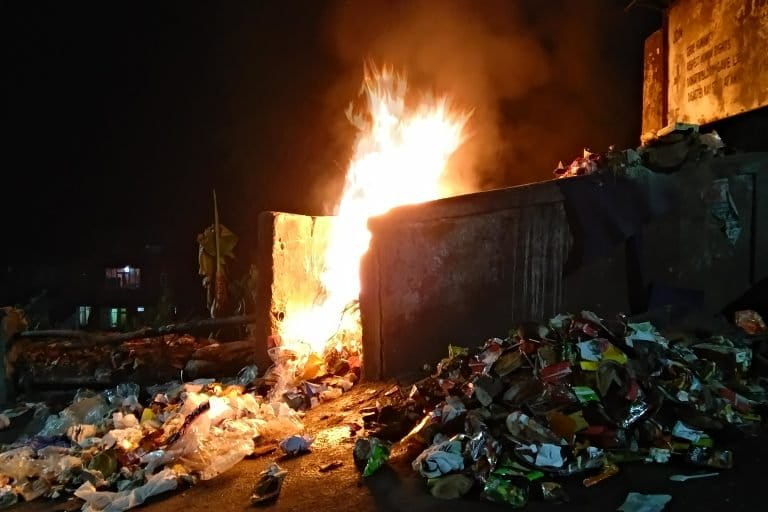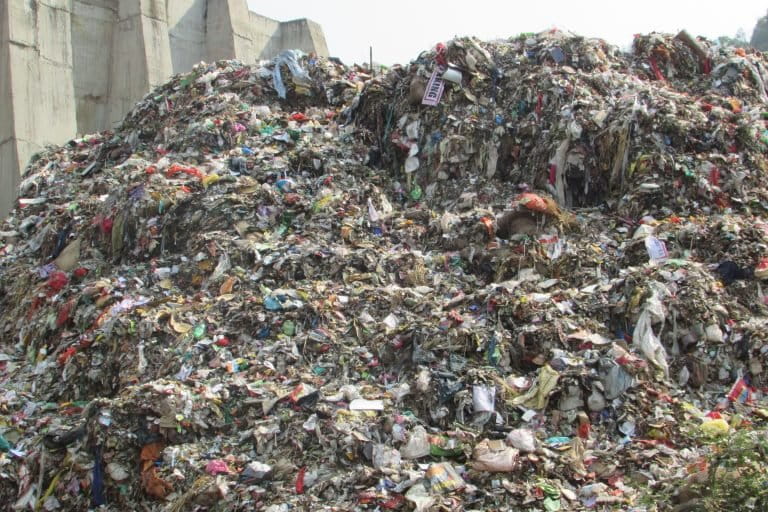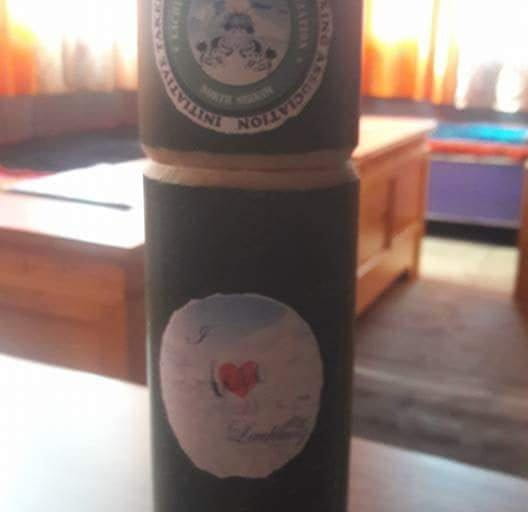- About eight percent of the municipal solid waste in India’s high-altitude cities is plastic. This is quite high and could be as a result of the floating population and tourist inflow.
- Experts advocate a separate waste management system for the Himalayan states.
- Grassroots innovations are driving the push for Zero Waste in Sikkim that stands out for its green policies among the Indian Himalayan states.
- ‘Beat plastic pollution’ is the theme for this year’s World Environment Day to be observed on June 5.
Strolling through idyllic mountain landscapes, soaking in the unbridled sun and breathing in the fresh air all seem to be the recipe for a perfect holiday. That is, until you come across a stinking heap of rubbish with peeking plastic wrappers glinting in the sunlight.
Administrators, experts and activists dealing with waste in high-altitude states opine there is a darker side to the stereotypical pristine image of the Indian Himalayas. Trash is piling up in the mountains.
And as the world gears up to beat plastic pollution on World Environment Day, they advocate the Zero Waste approach: eliminate rather than ‘manage’ waste.
Parsing through the municipal solid waste (MSW) components of 12 high-altitude cities in India, scientists from National Environmental Engineering Research Institute (CSIR-NEERI) in a 2016 study had shown that the plastic composition of the garbage generated is “quite high”.

These cities are Guwahati and Jorhat (Assam), Agartala (Tripura), Tura (Meghalaya), Imphal (Manipur), Aizawl (Mizoram), Shillong (Meghalaya), Kohima (Nagaland), Gangtok (Sikkim), Itanagar (Arunachal Pradesh), Nainital (Uttarakhand) and Shimla (Himachal Pradesh). While eight of these cities are located 1,100 metres above sea level, ten are from the northeast region.
The data analysis indicated that biodegradable components dominate with 54.83 percent, followed by inert materials, ash and debris at 21.06 percent.
The study funded by the Central Pollution Control Board also revealed the paper component of MSW at 8.77 percent, plastic at 8.18 percent, while glass and ceramics stood at 4.45 percent and metals at 2.71 percent.
“As we know, plastics weigh very less and in this study the percentage was calculated on a weight basis. This value (eight percent) is quite high. This quantity might reflect the floating population or tourist impact in the high altitude region,” Hiya Dhar of NEERI told Mongabay-India.
Dhar and colleagues advocate a separate waste management system for the Himalayan states and cities, observing that the conundrum of waste management in these locations is very different to the dilemma in the plains.
“The composition of waste needs to be tracked appropriately since these cities have floating population and the quantity of waste always keeps changing. This results in improper design criteria for the treatment and disposal method,” said Dhar.
There is limited space for landfills and those that are functional are far away incurring high transportation and labour costs. Low moisture content plays spoilsport with the composting of biodegradables that dominate the trash mix, explained Gangtok mayor Shakti Singh at a workshop on waste management in 12 mountain states, including Jammu and Kashmir, organised by WWF-India’s Sikkim office, Integrated Mountain Initiative and other stakeholders.

“Landfilling/dumping method is different in the mountain states. During our study it was found that the high-altitude cities were dumping their waste on the slopes. This means if proper guidelines are not followed by municipal authorities then MSW can litter mountains and hills, including the particular city, which impacts the mountains’ biodiversity,” Dhar stressed.
As ecotourism booms, plastic piles on due to the convenience of use-and-throw products on the go. Meanwhile, recycling efforts struggle to keep pace with this surge.
“Out of the states/cities that were studied, Sikkim is the best example in terms of implementation of policies to control waste, particularly plastic,” Dhar pointed out.
How Sikkim battles waste
In Sikkim, a tiny Himalayan state, that has a population of around 600,000, tourists number three times as much annually, adding on to the challenge of tackling plastic trash, said Singh.
The state, which has nearly 50 percent under forest cover, is famed for being a pioneer in green policies. It is the first Indian state to aim to be fully organic.
Way back in 1997, it became the first Indian state to ban disposable plastic bags. This was driven by reports of discarded plastic bags choking drainage system and the streams, resulting in water flows being diverted and causing a spate of landslides in and around Gangtok, Sikkim.
It is also among the first to target single-use plastic bottles. In 2016, Sikkim slapped a ban on use and sale of disposables made from Styrofoam. It has also prohibited use of packaged drinking water in government functions.

Plastics make up 17.18 percent of the waste in Sikkim, according to the Ecotourism and Conservation Society of Sikkim (ECOSS). Gangtok, the state capital, churns out around 20 to 30 tonnes of solid waste per day with the figure going up to 50 tonnes during the tourist season.
Non-recyclable plastics (instant noodles wrappers, chips packets among others) followed by PET bottles, glass bottles (alcohol), cardboard and Tetra Pak containers form the bulk of the non-biodegradable component as per a rapid assessment of the garbage situation in Sikkim that was conducted by ECOSS for the Zero Waste Himalaya group.
The magnitude of the problem can be gleaned from the fact that if all PET bottles from the annual waste in the state were laid end to end, they would cover a distance four times the length of the Teesta river, said Priya Shrestha of WWF Sikkim, quoting the assessment.
Similarly, if all the annually discarded Tetra Pak containers were stacked on top of one another they would form a pillar 22 times the height of Mt. Everest.
Grappling with non-biodegradables, the focus for the state is now on Zero Waste, said Singh.
“Our main source of revenue is ecotourism so we are very focused on Zero Waste. The target is segregation at source and that no waste should go to the landfill site because it is next to a river. Though the volume of waste is small in comparison to other states, we cannot be complacent because of the state’s association with biodiversity,” said Singh.
According to the Environmental Justice Atlas, four villages near Gangtok (Lower Martam, 14th Mile, Nimtar and Mangthang), are facing serious health problems due to unscientific and unregulated dumping of municipal waste from Gangtok town and other areas of the state in the Martam landfill site, the city’s only dedicated disposal ground.
“The load on our waste management system increases as the hotel occupancy increases. Three times more garbage is generated in the tourist season and since we consider them as guests we have to ensure everything runs smoothly,” Singh explained.

In other cities, throwing a banana peel out on the street might not be a big deal but in Sikkim it is, stressed Anil Raj Rai of the Rural Management and Development Department.
“Changing tourist behaviour is the biggest challenge to achieve Zero Waste. Virtually, every house is a hotel. We have to do away with the culture of use-and-throw. We have to cut down on disposables,” Rai added.
However, Rai admitted it is not just tourists alone who are to blame for the spurt in plastic.
“Even in villages, instead of using traditional eco-friendly ways, they are using plastic and Styrofoam,” Anil Raj Rai told Mongabay-India.
There has been a substantial increase in population of Sikkim with many people from the region settling within the state, large migrant populations engaged in road construction and other infrastructure development projects also contribute to the volume of trash, said Shrestha.
Unleashing innovations
Grassroots innovations and monitoring are at the heart of the push towards Zero Waste in some of the tourist hotspots in Sikkim given its emphasis on importance of global frameworks for guiding the national and local action.
About 118 km away from Gangtok and perched at a height of 8,610 feet is the mountain village of Lachung in north Sikkim, very close to the border with Tibet. It is a premier tourist destination enveloped in snow-capped mountain peaks, lakes and waterfalls and dotted with prayer flags.
With its unique system of self-governance called the ‘Dzumsa’ where all local disputes are settled by a representative body of the village headed by an elected ‘Pipon’, the hamlet is now combining the concept of cleanliness with religion for waste management.
The village has initiated a pilot of bamboo bottles for tourists following a ban on use of plastic mineral water bottles imposed by the Dzumsa last year (in 2017).
“Once the plastic water bottles were banned, we were asked to come up with alternative solutions. We were helped by bamboo specialist Ghani Zaman to come up with a prototype. The significance lies in the fact that these bottles are totally devoid of any synthetic chemicals. From treatment to manufacture, we use only organic components,” Thupden Lachungpa, a local who is involved in the project told Mongabay-India at the workshop.
It takes roughly three months, from the time the bamboo is set up for treatment till it reaches the consumers, to produce one bottle. The bottles are being sold at Rs 200 and if they return after using, they will get a refund of Rs 180. The manufacturing cost of each bottle is roughly Rs 100.

“It is a community involvement project where youngsters are involved. In a month’s time about 200 bottles will be rolled out,” Lachungpa said.
Supplementing eco-friendly efforts, the village is also for scouting for designated spots to tie prayer flags or ‘lungtas’. Since they are made up off synthetic material, the flags pollute water bodies once they flutter down after a few years, said Lachungpa.
“The tradition of tying flags is essential to our religion. It was discovered that the fish ingested the flags. So we reasoned with the head saying that this is indirectly killing the animals and this is going against our religion. So it was decided that the flags would be put up in specific areas and would also be monitored so they do not end up in the lakes. We are awaiting order of the Pipon and in the meantime we are creating awareness on this among the locals,” Lachungpa added.
Policy analyst and development consultant Amba Jamir agreed with the notion of a separate waste management system for mountain states but he also highlighted the challenge
“The challenge however is there is no real consensus on what the system should be or how it may be implemented. The states do not have neither the technical nor the financial capacities to formulate their own strategies. The current efforts of organisations to bring mountain states to talk and think together, therefore is very critical,” Jamir of Sustainable Development Forum Nagaland, told Mongabay-India.
He said the government of India must make a conscious effort to ensure that companies, consultants and go-betweens are not simply dumping ideas and technologies to mountain states.
“Providing funds is fine but the government must also provide appropriate solutions and technologies, including laws,” he added.
